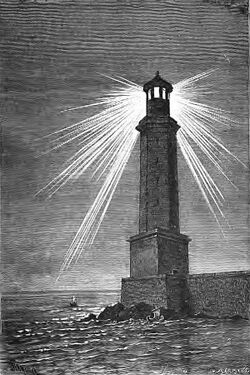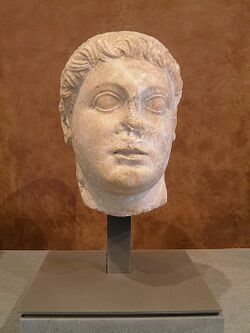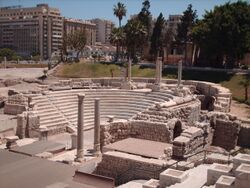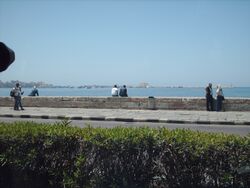How Was the Lighthouse of Alexandria Destroyed
Of all the Seven Wonders of the Ancient World, only the Great Pyramids of Giza in Egypt still remain. War, neglect, and natural disasters have wiped them from the face of the earth with only descriptions left by ancient historians and geographers, or perhaps an occasional coin or painting, as tokens of their greatness. Since the Seven Wonders were first formulated by Greeks, most of the Wonders were located in and around Greece, but two of them were found in Egypt.
Of course, as mentioned, the Great Pyramids of Giza are located in Egypt, but along with the Pyramids was the much younger but no less impressive Lighthouse of Alexandria, often called the “Pharos Lighthouse” for the island in the Mediterranean that it occupied. Among all the Seven Wonders, the Lighthouse of Alexandria was one of the most practical because it helped facilitate trade in and out of Egypt.
In terms of age, the Lighthouse of Alexandria existed in its original form, more or less, for about 1,000 years, which made it among the longest lived of the Seven Wonders. Because the Lighthouse no longer exists and has not for almost 1,000 years, great mystery surrounds its size and structure, but even greater is the perceived mystery of its destruction. Perhaps because it is often confused and/or included with the famed Library of Alexandria, rumors and falsehoods have persisted about the Lighthouse’s demise. An examination of the sources reveals that the Lighthouse of Alexandria fell victim to a number factors that led to its destruction including earthquakes and salt water erosion. Along with the damage the Lighthouse suffered from the elements, its prestige, and the prestige of the city of Alexandria itself, was greatly diminished when the Arab Muslims conquered Egypt in AD 642. To the Muslims, Alexandria was just not as important as it was to the Greeks and Romans and so they allowed the already decaying Lighthouse to fall further into disuse until they finally changed its function.
The Construction of the Lighthouse
Although located in Egypt, the city of Alexandria was founded by the Macedonian conqueror Alexander the Great when the wrested Egypt away from the Persians in 331 BC. Alexander liked the location of the area because of its natural harbor and so decided to build a city there as a monument to his greatness and to promote the Greek concept of Hellenism. Construction of the city began under the first of the Greek-Macedonian rulers of Egypt, Ptolemy I (ruled 305-282 BC), who commissioned the architect Dinocrates of Rhodes to design the city on a grid-pattern, which was quite revolutionary at the time. [1] The centerpiece of this bold new city would be the landmark known as the Pharos Lighthouse or Lighthouse of Alexandria.
Construction of the Lighthouse probably began during Ptolemy I’s reign, but was completed during the rule of his successor, Ptolemy II (284-246 BC). Although there is no consensus among modern historians, many believe that the dyke that joined the mainland to the Pharos island, known as the “Heptastadion,” was built during Ptolemy I’s reign, but most of the actual Lighthouse was constructed during Ptolemy II’s rule. [2] As was the case in many instances in the ancient world, it is not known for sure who was the architect of the Lighthouse. Ancient historians associated the name Sostratus with the Lighthouse in their writings and his name was supposedly inscribed on the edifice, so modern scholars believe that he was either its architect or one of the chief donors. [3]
Ancient Descriptions of the Lighthouse
Besides their references to the Lighthouse’s possible architect, the ancient writers are the best source for the modern understanding of the Lighthouse’s size, structure, and uses. Julius Caesar mentioned the Lighthouse in his military memoirs about the Civil Wars in the first century BC. By his own admission, Caesar’s troops caused damage to buildings on the Pharos Island near the Lighthouse during the Alexandria campaign in 48 BC and according to the first century BC Greek geographer, Strabo, the damage was significant.
“And likewise the extremity of the isle is a rock, which is washed all round by the sea and has upon it a tower that is admirably constructed of white marble with many stories and bears the same name as the island. This was an offering made by Sostratus of Cnidus, a friend of the kings, for the safety of mariners, as the inscription says: for since the coast was harbourless and low on either side, and also had reefs and shallows, those who were sailing form the open sea thither needed some lofty and conspicuous sign to enable them to direct their course aright to the entrance of the harbour. And the western mouth is also not easy to enter, although it does not require so much caution as the other. And it likewise forms a second harbour, that of Eunostus, as it is called, which was dug by the hand of man. For the harbour which affords the entrance on the side of the above-mentioned tower of Pharos is the Great Harbour, whereas these two lie continuous with that harbour in their innermost recess, being separated from it only by the embankment called the Heptastadium. The embankment forms a bridge extending from the mainland to the western portion of the island, and leaves open only two passages into the harbour of Eunostus, which are bridged over. However, this work formed not only a bridge to the island but also an aqueduct, at least when Pharos was inhabited. But in these present times it has been laid waste by the deified Caesar in his war against the Alexandrians, since it had sided with the kings.” [4]
Although Caesar’s troops caused a certain amount of destruction on the Pharos Island and also apparently to the Lighthouse itself, it took little time for the Romans to rebuild Egypt’s second entry into the Seven Wonders of the World. Alexandria continued to be an important city once its control passed from the Ptolemies to the Romans. The Romans apparently quickly repaired the damage to the Lighthouse because when the first century AD Jewish historian Josephus wrote about it, no damage was mentioned.
“For Egypt is difficult to enter by land, and the coast is almost harbourless. . . It is difficult even in peacetime for ships to approach the harbour of Alexandria; the entrance is narrow, and submerged rocks make a straight course impossible. The left side is shut in by artificial moles; on the right the island of Pharos lies off shore, and from this rises an enormous lighthouse whose fires are visible thirty-five miles away, warning visiting ships to anchor at night well away from the shore because of the difficulty of making port.” [5]

Besides demonstrating that the Lighthouse was functioning fully again about 100 years after Caesar’s campaign, Josephus’ passage relates that it was a true lighthouse, which used firewood as its source for light. Other ancient descriptions of the Lighthouse can be found on coins that were minted in Alexandria during the Roman period. The so-called “Pharos Coins,” which featured a depiction of the Lighthouse, were issued through the reigns of six emperors from Domitian through Marucs Auerilius and then again in the twenty-ninth year of Commodus. [6]
Based on the ancient descriptions, modern scholars believe that the Lighthouse stood between 400 and 660 feet tall and was divided into three levels. The base was a square, the middle an octagon, and the top level was circular, with a statue of Zeus proudly perched at the summit. [7]The Lighthouse of Alexandria must have truly been a remarkable sight, which makes the story of its destruction almost as important as its life.
The Destruction of the Lighthouse of Alexandria
As discussed above, the Lighthouse of Alexandria incurred its first recorded man-made damage at the hands of Julius Caesar. There were few accounts written about the Lighthouse after Josephus. The medieval Islamic historian, Ibn Battuta, visited Alexandria twice during his epic journeys of the Islamic world – 1326 and 1349 – and found the Lighthouse severely damaged on his first trip and all but destroyed on the second trip. Battua never gave an opinion on what caused the destruction. Thanks to advances in science, modern scholars have been able to determine that much of the damage the Lighthouse suffered in the post-Roman/Islamic Period was due to nature.
A number of devastating earthquakes that rocked Egypt during the medieval period probably caused most of the damage to the Lighthouse. One particularly strong earthquake, which was felt all over Egypt and as far away as Syria, destroyed the top level of the tower in 956. [8] Along with repeated earthquakes, erosion caused by the salt of the Mediterranean Sea appears to have played no insignificant role in the Lighthouse’s demise. Repeated wind-borne salt erosion would have caused damage to the exterior of the Lighthouse, which was already in disrepair due to the repeated earthquakes. [9] Although earthquakes and salt air erosion caused significant damage to the Lighthouse of Alexandria, the wonder still could have been rebuilt. The Lighthouse of Alexandria’s final demise came not through any single event, but was more the result of a cultural and demographic shift in the region.
Alexandria was a city built by Greeks and then inherited by the Romans and later the Byzantine Empire. To these peoples, Alexandria was an important place in their empires and the Lighthouse was the physical focal point of the city, both literally and metaphorically. When the Arab Muslims conquered Egypt in AD 642, they viewed the city of Alexandria and the Lighthouse in very different manner. Although the Muslims were impressed with certain aspects of Hellenic Civilization, they were not part of it and monuments such as the Seven Wonders of the World list were of little consequence to them. Egypt played an important role in the new caliphate, but the newly built city of Cairo, not Alexandria, became the focal point of medieval Egypt.
With that said, the Muslims did not totally abandon Alexandria or the Lighthouse. As mentioned above, Ibn Battuta knew of the Lighthouse, but by his time, it had long ceased to function as an actual lighthouse. During the ninth century, about a century before the large earthquake destroyed the top level, the lighthouse was converted into a mosque. [10] It is not known if the rulers of Egypt attempted to rebuild the Lighthouse-mosque after the devastating earthquake of the tenth century, but it is known that the Sultan Qaitbay converted what was left of the Lighthouse into a fort in 1480. [11]
Conclusion
Although the Lighthouse of Alexandria no longer exists, like five of the other original Seven Wonders of the Ancient World, it continues to inspire the imaginations of countless people throughout the world. For about 1,000 years the Lighthouse stood as a symbol of the city of Alexandria’s greatness, as well as providing a beacon for safe passage through the treacherous Alexandria harbor. Unfortunately, the great monument fell victim to a number of factors that resulted in its destruction. Earthquakes and erosion were responsible for most of the physical destruction to the Lighthouse, but when the Arab Muslims conquered Egypt they did not look at the monument with the same reverence as previous Hellenic peoples who occupied Alexandria. The city itself fell in importance with Islamic caliphs, who chose to convert what was physically left of the Lighthouse first into a mosque and then a fort.
References
- Jump up ↑ Clayton, Peter A. “The Pharos at Alexandria.” In The Seven Wonders of the Ancient World. Edited by Peter Clayton and Martin J. Price. (London: Routledge, 1999), p. 140
- Jump up ↑ Scheidel, Walter. “Creating a Metropolis: A Comparative Demographic Perspective.” In Ancient Alexandria between Egypt and Greece. Edited by W.V. Harris and Giovanni Ruffini. (Leiden: Brill, 2004), p. 23
- Jump up ↑ Clayton, pgs. 142-3
- Jump up ↑ Strabo. Geography. Translated by Horace Leonard Jones. (Cambridge, Massachusetts: Harvard University Press, 2001), Book XVII, 1.6
- Jump up ↑ Josephus. The Works of Josephus: Complete and Unabridged. Translated by William Whiston. (Peabody, Massachusetts: Hendrickson, 1987), Book IV, 6043
- Jump up ↑ Handler, Susan. “Architecture on the Roman coins of Alexandria.” American Journal of Archaeology 75 (1971), p. 182
- Jump up ↑ Claire, Thomas C. A Lighthouse for Alexandria: Pharos, Ancient Wonder of the World. (Portsmouth, New Hampshire: Black Channel Press, 2008), pgs. 56-60
- Jump up ↑ Claire, p. 94
- Jump up ↑ Claire, p. 123
- Jump up ↑ Claire, p. 94
- Jump up ↑ Claire, p. 138



